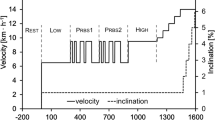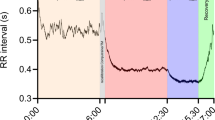Abstract
The aim of this study was to determine if subjects matched for \({\dot{V}}\hbox{O}_{\rm 2\,max}\) but with differing aerobic endurance displayed similar heart rate variability (HRV) at rest and heart rate recovery (HRR) after maximal exercise. We hypothesized that the higher the aerobic endurance, the higher the HRV and the faster the HRR. Twenty-eight well trained middle- and long-distance runners (24 men and 4 women) performed a maximal continuous graded exercise test for the determination of maximal oxygen consumption \(({\dot{V}\hbox{O}_{2\,\rm max}}),\) ventilatory threshold (VT), peak treadmill velocity (PTV) and HRR, as well as a test to measure the autonomic regulation of heart rate during supine rest, using HRV analysis. Once both tests were completed, subjects were matched for \({\dot{V}\hbox{O}_{2\,\rm max}}\) and assigned to the low endurance or the high endurance group, depending on the %PTV at which VT occurred (81.9 ± 2.9 and 88.3 ± 3.1%PTV for both groups, respectively; P < 0.0001). Contrary to our hypotheses, neither HRV nor HRR parameters were different between groups or associated with aerobic endurance. \({\dot{V}}\hbox{O}_{\rm 2\,max}\) (59.0±7.3 ml min−1 kg−1) was inversely correlated with ln SDNN (r = −0.44, P < 0.05), ln HF (r = −0.52, P < 0.05), ln LF + HF (r = −0.53, P < 0.05). These results suggest that aerobic endurance is not associated with cardiovascular autonomic control, as measured by HRV and HRR.
Similar content being viewed by others
References
Antelmi I, de Paula RS, Shinzato AR, Peres CA, Mansur AJ, Grupi CJ (2004) Influence of age, gender, body mass index, and functional capacity on heart rate variability in a cohort of subjects without heart disease. Am J Cardiol 93:381–385
Arai Y, Saul JP, Albrecht P, Hartley LH, Lilly LS, Cohen RJ, Colucci WS (1989) Modulation of cardiac autonomic activity during and immediately after exercise. Am J Physiol 256:H132–H141
Aubert AE, Seps B, Beckers F (2003) Heart rate variability in athletes. Sports Med 33:889–919
Aunola S, Rusko H (1984) Reproducibility of aerobic and anaerobic thresholds in 20–50 year old men. Eur J Appl Physiol Occup Physiol 53:260–266
Bosquet L, Leger L, Legros P (2002) Methods to determine aerobic endurance. Sports Med 32:675–700
Buchheit M, Gindre C (2006) Cardiac parasympathetic regulation: respective associations with cardiorespiratory fitness and training load. Am J Physiol 291:H451-H458
Cohen J (1988) Statistical power analysis for the behavioral sciences. Lawrence Erlbaum Associates edn, Hillsdale
di Prampero PE, Atchou G, Bruckner JC, Moia C (1986) The energetics of endurance running. Eur J Appl Physiol Occup Physiol 55:259–266
Duncan GE, Howley ET, Johnson BN (1997) Applicability of VO2 max criteria: discontinuous versus continuous protocols. Med Sci Sports Exerc 29:273–278
Freeman R (2004) Assessment of cardiovascular autonomic function. Suppl Clin Neurophysiol 57:369–375
Gamelin FX, Berthoin S, Bosquet L (2006) Validity of the polar S810 heart rate monitor to measure R–R intervals at rest. Med Sci Sports Exerc 38:887–893
Goldberger JJ, Kim YH, Ahmed MW, Kadish AH (1996) Effect of graded increases in parasympathetic tone on heart rate variability. J Cardiovasc Electrophysiol 7:594–602
Green JM, Crews TR, Bosak AM, Peveler WW (2003) A comparison of respiratory compensation thresholds of anaerobic competitors, aerobic competitors and untrained subjects. Eur J Appl Physiol 90:608–613
Hedelin R, Wiklund U, Bjerle P, Henriksson-Larsen K (2000) Cardiac autonomic imbalance in an overtrained athlete. Med Sci Sports Exerc 32:1531–1533
Imai K, Sato H, Hori M, Kusuoka H, Ozaki H, Yokoyama H, Takeda H, Inoue M, Kamada T (1994) Vagally mediated heart rate recovery after exercise is accelerated in athletes but blunted in patients with chronic heart failure. J Am Coll Cardiol 24:1529–1535
Javorka M, Zila I, Balharek T, Javorka K (2002) Heart rate recovery after exercise: relations to heart rate variability and complexity. Braz J Med Biol Res 35:991–1000
Kuch B, Hense HW, Sinnreich R, Kark JD, von Eckardstein A, Sapoznikov D, Bolte HD (2001) Determinants of short-period heart rate variability in the general population. Cardiology 95:131–138
Lee CM, Wood RH, Welsch MA (2003) Influence of short-term endurance exercise training on heart rate variability. Med Sci Sports Exerc 35:961–969
Leicht A, Allen G, Hoey A (2003) Influence of intensive cycling training on heart rate variability during rest and exercise. Can J Appl Physiol 28:898–909
Malpas SC, Maling TJ (1990) Heart-rate variability and cardiac autonomic function in diabetes. Diabetes 39:1177–1181
Melanson EL, Freedson PS (2001) The effect of endurance training on resting heart rate variability in sedentary adult males. Eur J Appl Physiol 85:442–449
Perini R, Orizio C, Comande A, Castellano M, Beschi M, Veicsteinas A (1989) Plasma norepinephrine and heart rate dynamics during recovery from submaximal exercise in man. Eur J Appl Physiol Occup Physiol 58:879–883
Peronnet F, Aguilaniu B (2006) Lactic acid buffering, non-metabolic CO2 and exercise hyperventilation: a critical reappraisal. Respir Physiol Neurobiol 150:4–18
Peronnet F, Thibault G (1989) Mathematical analysis of running performance and world running records. J Appl Physiol 67:453–465
Peronnet F, Thibault G, Rhodes EC, McKenzie DC (1987) Correlation between ventilatory threshold and endurance capability in marathon runners. Med Sci Sports Exerc 19:610–615
Pichot V, Busso T, Roche F, Garet M, Costes F, Duverney D, Lacour J, Barthelemy J (2002) Autonomic adaptations to intensive and overload training periods: a laboratory study. Med Sci Sports Exerc 34:1660–1666
Sandercock GR, Shelton C, Bromley P, Brodie DA (2004) Agreement between three commercially available instruments for measuring short-term heart rate variability. Physiol Meas 25:1115–1124
Sandercock GR, Bromley PD, Brodie DA (2005) The reliability of short-term measurements of heart rate variability. Int J Cardiol 103:238–247
Saul JP, Arai Y, Berger RD, Lilly LS, Colucci WS, Cohen RJ (1988) Assessment of autonomic regulation in chronic congestive heart failure by heart rate spectral analysis. Am J Cardiol 61:1292–1299
Task-Force (1996) Heart rate variability: standards of measurement, physiological interpretation and clinical use. Circulation 93:1043–1065
Tsuji H, Larson MG, Venditti FJ Jr, Manders ES, Evans JC, Feldman CL, Levy D (1996) Impact of reduced heart rate variability on risk for cardiac events. The Framingham heart study. Circulation 94:2850–2855
Uusitalo AL, Laitinen T, Vaisanen SB, Lansimies E, Rauramaa R (2002) Effects of endurance training on heart rate and blood pressure variability. Clin Physiol Funct Imaging 22:173–179
Vinik AI, Maser RE, Mitchell BD, Freeman R (2003) Diabetic autonomic neuropathy. Diabetes Care 26:1553–1579
Wasserman K, Whipp BJ, Koyl SN, Beaver WL (1973) Anaerobic threshold and respiratory gas exchange during exercise. J Appl Physiol 35:236–243
Author information
Authors and Affiliations
Corresponding author
Rights and permissions
About this article
Cite this article
Bosquet, L., Gamelin, FX. & Berthoin, S. Is aerobic endurance a determinant of cardiac autonomic regulation?. Eur J Appl Physiol 100, 363–369 (2007). https://doi.org/10.1007/s00421-007-0438-3
Accepted:
Published:
Issue Date:
DOI: https://doi.org/10.1007/s00421-007-0438-3




